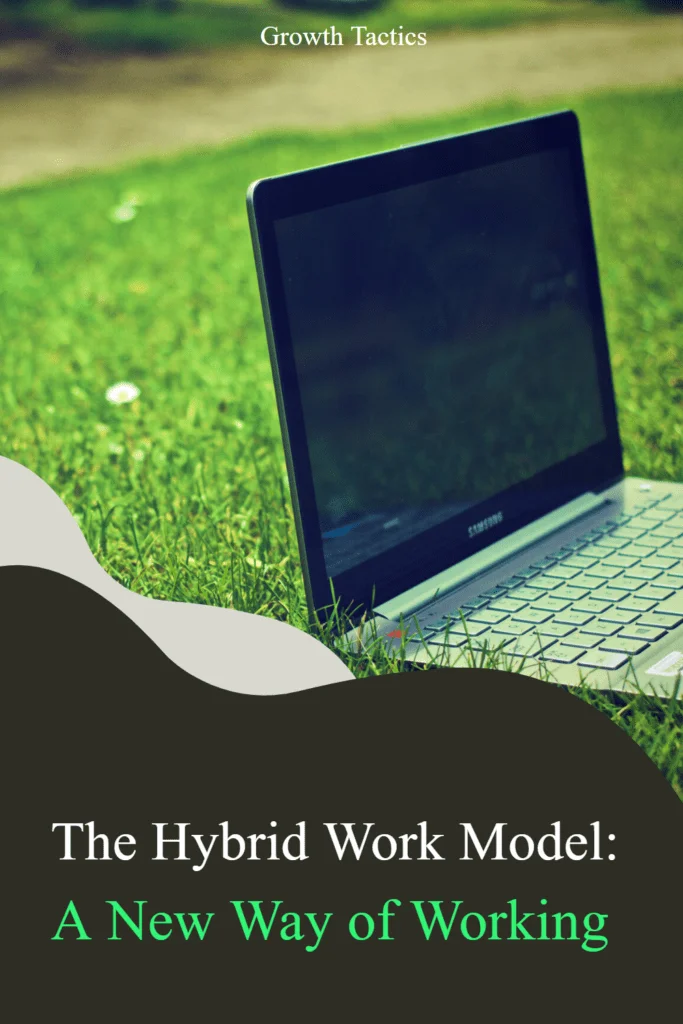As the world continues to evolve, so does the way we work. The traditional 9-5 workday in a centralized office is no longer the only option for employees. The hybrid work model is becoming more popular, and for good reason. This model allows for more work options that benefit both employees and organizations.
Jump To Section
What is the Hybrid Work Model?
The hybrid work model is a type of work arrangement that allows employees to work from both the office and remotely. This type of hybrid work can take on many different forms, depending on the needs of the organization and the employees. For example, some employees may work from home two days a week and come into the office for the other three days. Others may work remotely full-time, but come into the office for important meetings and events.
Pros and Cons of a Hybrid Work Model
| Pros | Cons |
|---|---|
| Increased flexibility for employees | Potential communication challenges |
| Improved work-life balance | Difficulty in maintaining company culture |
| Cost savings on office space and related expenses | Increased technology and infrastructure costs |
| Access to a wider talent pool | Potential for inequality between remote and in-office workers |
| Enhanced productivity for some employees | Complexity in managing hybrid teams |
| Reduced commute times and associated stress | Possible feelings of isolation for remote workers |
| Better ability to accommodate diverse employee needs | Challenges in scheduling and coordinating meetings |
| Potential for increased job satisfaction | Security concerns with remote work setups |
| Improved business continuity during disruptions | Potential for overwork and burnout |
| Opportunity for more efficient use of office space | Difficulty in spontaneous collaboration and innovation |
Types of Hybrid Work Models
There are many different types of hybrid work models that organizations can adopt. The type of hybrid work model that works best for your organization will depend on a variety of factors, including the type of work you do and the needs of your employees. Here are some of the most common types of hybrid work models:
The Remote-First Hybrid Model
In a remote-first hybrid model, the default is for employees to work remotely. This means that the organization has a remote-first culture, and employees are encouraged to work from home or another remote location. In this model, employees may come into the office for important meetings or events, but the majority of their work is done remotely.
The Office-First Hybrid Model
In an office-first hybrid model, the default is for employees to work in the office. This means that the organization has an office-first culture, and employees are expected to come into the office for the majority of their work. In this model, employees may be allowed to work remotely on occasion, but the default is to work in the office.
The Flex Hybrid Model
The flex hybrid model is a combination of the remote-first and office-first models. In this model, employees have the flexibility to choose where they work based on their needs and the needs of the organization. For example, employees may work from home two days a week and come into the office for the other three days.
The Shift Hybrid Model
In a shift hybrid model, employees work in the office and remotely on a rotating schedule. For example, one group of employees may work in the office on Monday, Wednesday, and Friday, while another group works in the office on Tuesday and Thursday. This model allows for a balance between in-office and remote work.
The Task-Based Hybrid Model
In a task-based hybrid model, employees work remotely or in the office based on the type of work they are doing. For example, employees may work in the office for collaborative tasks that require face-to-face interaction, and work remotely for tasks that require heads-down work.
The Hybrid Workforce Model
In a hybrid workforce model, some employees work in the office full-time, while others work remotely full-time. This model allows for flexibility for both in-office and remote workers and can be beneficial for organizations with a geographically dispersed workforce.
Regardless of the type of hybrid work model, it’s important to choose a model that works best for your organization and your employees. By providing flexibility and a balance between in-office and remote work, organizations can benefit from increased productivity and job satisfaction.
Benefits of a Hybrid Work Model
One of the biggest benefits of a hybrid work model is the flexibility it provides. Employees can choose to work from a location that best suits their needs, whether that’s at home or in the office. This flexibility can lead to increased job satisfaction and productivity. It also allows employees to better balance their work and personal lives.
Another benefit of the hybrid work model is the cost savings for organizations. With fewer employees in the office, organizations can save on office space and other related expenses. This can be especially beneficial for smaller organizations that may not have the resources to maintain large office space.
Is a Hybrid Workplace Right for You?

While the hybrid work model has many benefits, it may not be the right fit for every organization. Here are some factors to consider when deciding if a hybrid workplace is right for you:
Type of Work
The type of work that your organization does may impact whether a hybrid workplace is a good fit. For example, if your work requires a lot of collaboration and face-to-face interaction, a fully remote model may not be the best fit. On the other hand, if your work is more independent and can be done remotely, a hybrid model may work well.
Company Culture
Company culture is an important factor to consider when deciding if a hybrid workplace is right for you. If your organization has a strong in-office culture, it may be challenging to shift to a hybrid model. However, if your organization is open to change and values flexibility, a hybrid model may be a good fit.
Employee Needs
It’s important to consider the needs of your employees when deciding if a hybrid workplace is right for you. Some employees may prefer to work in the office full-time, while others may prefer to work remotely. It’s important to find a balance that works for everyone and provides flexibility for employees to work in a way that suits their needs.
Technology Infrastructure
A successful hybrid workplace requires the right technology infrastructure. This includes video conferencing software, project management tools, and other tools that allow remote employees to work effectively. It’s important to ensure that your organization has the right technology in place before implementing a hybrid workplace.
Cost
A hybrid workplace can be cost-effective for organizations, but it’s important to consider the costs associated with implementing a hybrid workplace. This includes the cost of technology infrastructure, office space, and other related expenses.
By considering these factors, organizations can determine if a hybrid workplace is right for them. While a hybrid workplace may not be the best fit for every organization, it can provide flexibility and increased productivity for those that are open to change.
Best Practices for a Successful Hybrid Work Model

To ensure that a hybrid work model is successful, there are a few best practices that organizations should follow. First, it’s important to establish clear guidelines and expectations for employees. This includes outlining work hours, communication protocols, and the type of work that can be done remotely.
Another best practice is to create a hybrid work environment that is inclusive for all employees. This means ensuring that remote employees have the same access to resources and opportunities as in-office employees. It also means creating a culture that values both in-office and remote work.
Maintaining a Positive Hybrid Work Environment
Maintaining a positive work environment is important for any organization, but it can be particularly challenging in a hybrid work model. Here are some tips for maintaining a positive hybrid work environment:
Communication
Effective communication is key to maintaining a positive hybrid work environment. It’s important to establish clear communication protocols and ensure that all team members are on the same page. This includes regular check-ins, team meetings, and one-on-one meetings with both in-office and remote employees.
Inclusivity
Creating an inclusive work environment is important for maintaining a positive hybrid work environment. This means ensuring that remote employees have the same access to resources and opportunities as in-office employees. It also means creating a culture that values both in-office and remote work.
Flexibility
Flexibility is key to maintaining a positive hybrid work environment. It’s important to be flexible with work hours and schedules and to ensure that employees have the flexibility to work from a location that best suits their needs. This can lead to increased job satisfaction and productivity.
Team Building
Team building is important for maintaining a positive work environment in a hybrid model. This includes both virtual and in-person team-building activities. Virtual team-building activities can include online games or virtual happy hours, while in-person activities can include team outings or volunteer activities.
Recognition and Rewards
Recognizing and rewarding employees is important for maintaining a positive hybrid work environment. This can include both formal and informal recognition, such as employee of the month awards or shoutouts during team meetings. It’s important to ensure that all employees feel valued and appreciated, regardless of where they work.
By following these tips, organizations can maintain a positive work environment in a hybrid model. This can lead to increased job satisfaction and productivity for all employees.
Managing Hybrid Teams

Managing hybrid teams can be a challenge, but with the right strategies in place, it can be done successfully. Here are some best practices for managing hybrid teams:
Communication
Effective communication is key when managing hybrid teams. It’s important to establish clear communication protocols and ensure that all team members are on the same page. This includes regular check-ins, team meetings, and one-on-one meetings with both in-office and remote employees.
Technology
Technology plays a crucial role in managing hybrid teams. It’s important to have the right tools in place to ensure that remote employees have access to the same resources and opportunities as in-office employees. This includes video conferencing software, instant messaging apps, and project management tools.
Inclusivity
It’s important to create an inclusive work environment for all employees, regardless of whether they work in the office or remotely. This means ensuring that remote employees have the same access to resources and opportunities as in-office employees. It also means creating a culture that values both in-office and remote work.
Trust
Trust is essential when managing hybrid teams. It’s important to trust that employees are getting their work done, regardless of whether they are working in the office or remotely. This means focusing on results rather than the number of hours worked.
Flexibility
Flexibility is key when managing hybrid teams. It’s important to be flexible with work hours and schedules and to ensure that employees have the flexibility to work from a location that best suits their needs. This can lead to increased job satisfaction and productivity.
Training
Training is important when managing hybrid teams. It’s important to provide training on communication protocols, technology, and best practices for working in a hybrid environment. This can help to ensure that all team members are on the same page and can work effectively together.
By following these best practices, organizations can successfully manage hybrid teams and benefit from increased productivity and job satisfaction.
The Future of Work
The shift to hybrid work is here to stay. As more organizations adopt a hybrid work model, it’s important to choose the best hybrid work policy for your organization. This may mean implementing a hybrid work model that allows for both in-office and remote work, or it may mean adopting a fully remote or office-first model.
Regardless of the type of hybrid work model, it’s clear that hybrid work is a flexible and effective way of working. By allowing employees the flexibility to work from a location that best suits their needs, organizations can benefit from increased productivity and job satisfaction.
Did you enjoy this article on hybrid work models? Don’t forget to share and subscribe for more Growth Tactics.


